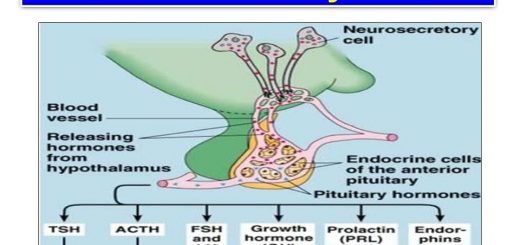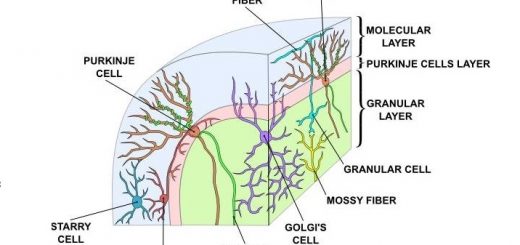Anterior pituitary gland function, hormones, location and Effects of Growth Hormone
The pituitary gland consists of the anterior pituitary & the posterior pituitary, The major organ of the endocrine system is the anterior pituitary, it is also called the adenohypophysis or pars anterior, it is the glandular, anterior lobe that together with the posterior lobe (posterior pituitary, or the neurohypophysis) makes up the pituitary gland (hypophysis), The anterior pituitary regulates physiological processes, including stress, growth, reproduction, and lactation.
Anterior pituitary gland
Hormones of the Anterior Pituitary are:
- Thyroid-stimulating Hormone (TSH) acts on the thyroid gland.
- Adenocorticotrophie Hormone(ACTH) acts on the adrenal cortex.
- Gonadotrophic hormones (FGH & L) act on the testes & ovaries.
- Prolactin hormone act on the mammary gland (PrL).
- Growth hormone (GH) affecting growth.
Control of Anterior Pituitary Secretion by Hypothalamus
Release of the anterior pituitary hormones is regulated by hypothalamic releasing and inhibiting hormones. They are synthesized in the hypothalamic nuclei and released from the axonal ending passing into the hypophyseal portal system to affect the cells of the pars distalis by inhibiting or stimulating the release of its hormones.
Hypothalamic Releasing and Inhibitory Hormones
For each type of the anterior pituitary hormone, there is a corresponding hypothalamic releasing hormone, for some of the anterior pituitary hormones, there is also a corresponding hypothalamic inhibitory factor or hormone.
The hypothalamic releasing and inhibitory hormones are:
- Growth Hormone releasing Hormone (GHRH), which causes the release of growth hormone.
- Growth Hormone inhibitory Hormone (GHHI), which is the same as the hormone somatostatin (SS) which inhibits the release of Growth Hormone.
- Prolactin inhibitory hormone (PrLIH) or (dopamine), which causes inhibition of prolactin secretion.
- Prolactin releasing hormone (PILIH) which cause an increase in prolactin secretion
- Thyroid-stimulating hormone-releasing hormone (TRH), which causes the release of thyroid-stimulating Hormone.
- Corticotropin-releasing Hormone or factor (CRF), which causes the release of adrenocorticotropin.
- Luteinizing Hormone-Releasing Hormone (LHRH), which causes the release of both luteinizing hormone & follicle-stimulating hormone, this hormone is also called gonadotropin-releasing Hormone (GnRH).
Growth hormone (Somatotrophic Hormone or Somatotropin)
It is a small protein molecule formed of multiple amino acids. It causes growth of all tissues of the body that are capable of growing including bone, muscles, and viscera. It promotes both increased size of the cell and mitosis with the development of a large number of cells.
Actions of the Growth Hormone
I) Effect on cartilage and bone:
Growth hormone acts indirectly on cartilage and bone by causing mainly the liver and other tissue to form several proteins called Somatomedins (A,B&C), they are polypeptide growth factors, which are called insulin-like growth factors.
Somatomedins stimulate the proliferation of chondrocytes and the appearance of osteoblasts. They are required for deposition of Chondroitin sulphate and collagen, both of which are necessary for cartilage growth, Bone growth is secondary to the formation of cartilage. In the long bone growth occur by increasing the thickness of the epiphyseal endplates.
As the epiphyseal plates widen, it adds more matrix at the end of long bones leading to an increase the length of the body. After epiphyseal closure, bone length doesn’t increase but thickening can occur through periosteal growth.
II) Metabolic functions:
A) On protein:
- Growth Hormone increases the transport of amino acids through the cell membrane to the interior of the cell. Increased concentration of amino acid inside cells is responsible for the increased protein synthesis.
- Growth H. increases protein synthesis by the ribosomes, this is caused by a direct effect on the ribosomes, which produce greater numbers of protein molecules.
- Growth H. stimulates the transcription of DNA in the nucleus causing the formation of large quantities of RNA, This promotes protein synthesis and also promotes growth.
- Growth H. decreases catabolism of protein and amino acid, (i.e protein sparer).
B) On fat:-
Growth H. has a lipolytic effect, it increases the utilization of fat leading to the release of fatty acids from adipose tissue to the body fluids. In addition, in the tissue, it enhances the conversion of fatty acids to acetyl-Co A to give energy.
C) On Carbohydrates:
- It diminishes uptake of glucose by the cells, with excess growth hormone may lead to increased blood glucose levels.
- It decreases the number of insulin receptors.
- It decreases utilization of glucose for energy. The decrease may result from the increased mobilization and utilization of fatty acids for energy.
- It increases glycogen deposition. The glucose that does enter the cells rapidly changed to glycogen and deposited. So the cells become saturated with glycogen.
II) Other functions:
- It stimulates erythropoiesis.
- It increases gastrointestinal absorption of calcium, and maintains phosphorus balance.
- It decreases the rate of urinary excretion of sodium and potassium because these electrolytes are needed for the growing tissue.
Pituitary gland function, structure, location, hormones & anatomy
Endocrine system structure, function, disorders, Endocrine Glands & Hormones types
Endocrine system, Endocrine glands, Pituitary gland & Hormonal coordination in living organisms
Adrenal ( suprarenal ) glands, Pancreas & Sex glands (Gonads)
Thyroid gland, Diseases of thyroid gland & Function of Parathyroid glands
Regulation of Growth Hormone Secretion & Effects of Deficiency of Anterior Pituitary Hormones



